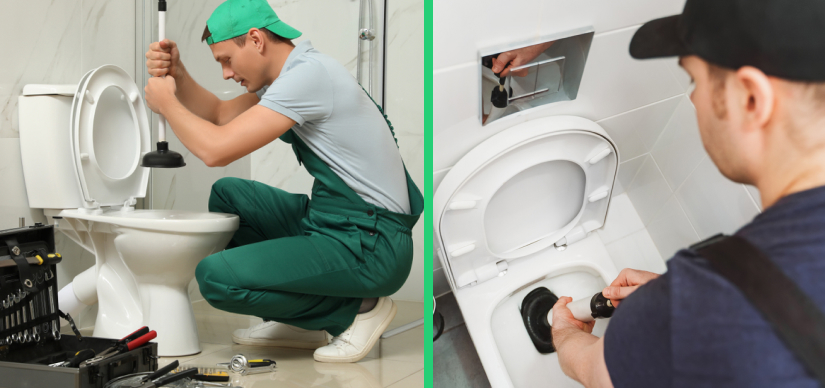The Easiest Way to Use a Toilet Plunger
The toilet plunger is a reliable tool in a clogged toilet situation. Such a distressing situation needs quick action to keep things under control and prevent a mess. So, an appropriate tool and the proper unclogging technique can simplify the task. Restoring your toilet faster is crucial, yet it takes a little time and the right effort. So, here are the elaborate details on how to use a toilet plunger.
Understand the Working of a Plunger
- The action of a plunger includes creating a tight seal around the drain. The purpose is to stop air from escaping and create suction pressure.
- A repeated motion of alternate push and pull builds up the pressure within the pipe. This dislodges and breaks the obstruction.
- As the obstruction clears, you will notice that the water starts to flow through the pipe, indicating a dislodged drain.
Here is How to Use a Toilet Plunger
A clogged toilet situation could appear intimidating. However, the right tools and techniques will help accomplish drainage restoration. Here are the basics and steps for using a toilet plunger effectively.
Fundamentals of using a Toilet Plunger
Begin by understanding the types of plungers that will help in unclogging. The first type is the cup plunger with a rubber cup affixed to a handle. The other type, the flange plunger, is recognized as a toilet auger. It has a flange or a collar that extends from the cup’s rim. This extension creates a seal around the toilet’s drain opening.
Step 1: Preparation
- Be ready with the supplies. In addition to the plunger, rubber gloves are required to prevent direct contact and a bucket to collect excess water.
- Start by turning off the fixture’s water supply. Next, grab a bucket and carefully remove some water from the bowl until it is half full. This will prevent splashing and make the cleanup process much easier.
- If you opt to use a cup plunger, see that it is clean and free from debris.
Step 2: Positioning
- Positioning involves placing the plunger directly over the drain hole of the toilet bowl. Correctly placing the plunger with a secure seal around the opening to optimize suction power.
- If the plunger comes with a flange, carefully press it into the drain hole until it sits securely. This improves the effectiveness of the plunging action as it prevents air from escaping.
- This positioning stage is essential for facilitating efficient plunging and dislodging of any obstructions in the drain pipe.
Step 3: Create a Seal
- After setting the position, push down the plunger firmly to form a tight seal. Press the plunger against the bottom of the bowl to confirm that there are no gaps for air to escape.
- Eliminating any potential leakage points optimizes the plunging action and helps thoroughly clear the obstruction.
Step 4: Plunge Away
- Now, there is a need to use both hands and exert rhythmic pressure to push and pull the plunger. See that a steady, controlled motion is followed. A consistent pace ensures the seal is in place.
- A smooth plunging rhythm optimizes suction force and increases the effectiveness of the dislodging. Here, the grip maintenance on the plunger handle is most important. So, a firm grip with a controlled action keeps the plunger in place throughout the plunging process.
Step 5: Keep Going
- Once you start plunging, keep going for about 20 to 30 seconds or till you feel resistance.
- In the case of a cup plunger, a gurgling sound after continuous action indicates air is moving through the clog.
Step 6: Test the Drain
- After the persistent plunging, flush the toilet to check if the drain is unclogged. A freely flowing water without any resistance indicates successful dislodgement.
- Any backup signs, such as slow drainage or water backing up, should be checked. It means that further action is required. Repeat the plunging process and focus on maintaining a secure seal. See that a consistent pressure is applied to break the clogging.
- Note that stubborn clogs may require multiple attempts to clear off. Patience and persistence are key.
- Continue assessing the toilet’s drainage after each round of plunging. A professional service might be required if the clog still does not go.
- If you observe these signs after plunging, the clog has likely been successfully cleared-
- Free-flowing water
- Normal water level
- Reduced gurgling
- Improved flushing performance
- Absence of odors
- No visible signs of debris or blockage
Step 7: Clean Up
- As the clog clears up, remove the plunger. Discard the collected water or debris from the bucket, then wash your hands with soap and water.
Step 8: Preventative Maintenance
- Future clogging can be avoided through simple preventative maintenance. Regularly cleaning your toilet is a priority.
- Avoid flushing items that cause blockages. Avoid flushing feminine hygiene products and paper towels or toilet paper.
Selecting a Toilet Plunger for Effectively Unclogging the Drain
- A larger plunger cup creates a complete seal and more potent suction for standard bowls.
- Creating a tight fit, a smaller cup makes a more appropriate plunger for the elongated toilet.
- Consider a plunger design that prioritizes hygiene and convenience. Options with removable heads and antimicrobial properties are also available. One may also look for models with drip trays, which make storage and drainage easy.
- While making a purchase, check the user reviews. See if the product is recommended more to check its performance and reliability. Consider reviewing customers’ feedback regarding durability, effectiveness, and ease of use.
Finding the Best Toilet Bowl Plunger
- A reliable plunger provides assurance when tackling stubborn clogs in drains.
- Choose a toilet plunger crafted from a durable and flexible material. The best toilet bowl plunger is made with high-grade rubber, which will last for years. The plunger cup should create a tight seal over the drain for optimum suction.
- See that the handle is sturdy and offers a comfortable grip.
Using A Professional Toilet Plunger
- A professional toilet plunger makes the task of most stubborn toilet clogs simpler. These plungers are more efficient in dealing with challenging plumbing issues.
- Heavy-duty engineering provides durability that can withstand repeated use without losing effectiveness.
- The material of the rubber cup is bigger and more durable than that of standard plungers. The larger size and durability make a tight seal against the toilet bowl. This provides high pressure and suction to break the clogs.
- Professional toilet plungers have longer handles than the standard ones. This is an advantage as users can apply more force with less effort. The comfortable grip design minimizes hand fatigue, even during extended use.
- Some professional plungers have additional features for better usability and hygiene maintenance. Drip trays and splash guards minimize messes, thus keeping surroundings clean. These features make the process simpler and less messy for users.
- Air plunger toilets or Air-powered plungers deliver a powerful burst of compressed air into the drain, which can effectively dislodge even the most stubborn clogs. These plungers are typically straightforward to use and create suction with a button or trigger press. This is why it is ideal for individuals with difficulty using traditional plungers.
- TOTO toilet plungers are designed for ease of use. However, its use is restricted to TOTO Toilets. These provide perfect fit and seamless operation. This plunger has a heavy-duty rubber build for tackling tough clogs. Its ergonomic handles make it user-friendly.
- So, investing in a high-quality plunger is a wise choice, whether you are a homeowner or a professional plumber.
Conclusion
Knowing how to use a toilet plunger confidently helps tackle a clogging situation in the bathroom. Knowledge of all the parts and their use enables the tool to be used effectively. The step-by-step guide provided allows one to practice handling a tricky situation. With practice and patience, you will be a pro in no time.


